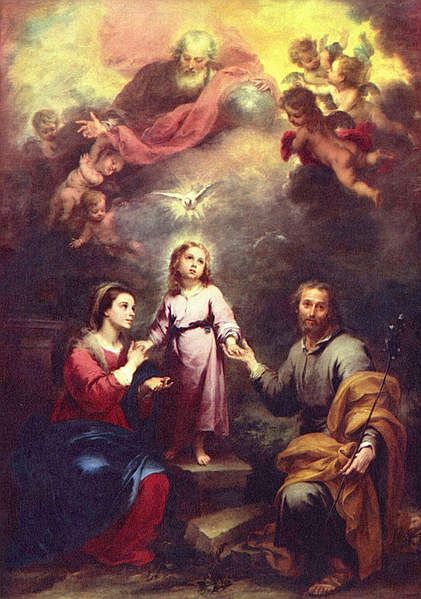Catholic Masterpieces II: "The Two Trinities"
[Updated on 18 February 2009 to fix inactive image.]
It's time for the second installment of my blog's feature, Catholic Masterpieces.
This week, I decided to feature a painting that I saw last month in the National Gallery, which is in London. The National Gallery is also the home of the Wilton Diptych, which I featured as my first Catholic Masterpiece. I forgot to mention that fact in my post about it. I don't remember actually seeing the Diptych, since I was in a sleep-deprived and jet-lagged state when I visited the Gallery with a friend of mine, who now lives over in England. But I do distinctly remember seeing this week's Catholic Masterpiece, which is titled The Two Trinities.

The Two Trinities was painted by a Spanish artist named Bartolome Esteban Murillo in the second half of the seventeenth century. Murillo lived in the city of Seville, and painted for religious communities and churches there. He is also known for his depictions of Mary and the Christ Child.
The Holy Trinity of the Father, Son, and Holy Ghost is shown in the vertical axis of the painting. God The Father is at the top of the painting, "floating" in the clouds and surrounded by angels. He looks down upon His Son, who is depicted as a Child, and is flanked by His Mother Mary and His foster father, St. Joseph. The Child Jesus holds their right hands. Between the Father and the Son is the Holy Ghost, which is symbolized in the traditional manner as a dove.
When I was browsing the various works of art in the National Gallery, I came upon this painting, and I was really touched. It really made an impression on me, even in my fatigued condition. The symbolism of this painting is rich. The Virgin Mary is looking toward her Son, and holds her left hand upwards, as if she was presenting Jesus to us. This is consistent with the Catholic Church's teaching that the best way to Jesus is through His Mother. St. Joseph, who is my favorite saint after Our Lady, is the only figure to be "looking" at us. To me, his expression is one of loving sympathy for us who are in the vale of tears.
May the Holy Trinity have mercy on us, and may the Holy Family be the example of all families on earth.
(To browse some other painting by Murillo, go to Art Renewal.org)
It's time for the second installment of my blog's feature, Catholic Masterpieces.
This week, I decided to feature a painting that I saw last month in the National Gallery, which is in London. The National Gallery is also the home of the Wilton Diptych, which I featured as my first Catholic Masterpiece. I forgot to mention that fact in my post about it. I don't remember actually seeing the Diptych, since I was in a sleep-deprived and jet-lagged state when I visited the Gallery with a friend of mine, who now lives over in England. But I do distinctly remember seeing this week's Catholic Masterpiece, which is titled The Two Trinities.

The Two Trinities was painted by a Spanish artist named Bartolome Esteban Murillo in the second half of the seventeenth century. Murillo lived in the city of Seville, and painted for religious communities and churches there. He is also known for his depictions of Mary and the Christ Child.
The Holy Trinity of the Father, Son, and Holy Ghost is shown in the vertical axis of the painting. God The Father is at the top of the painting, "floating" in the clouds and surrounded by angels. He looks down upon His Son, who is depicted as a Child, and is flanked by His Mother Mary and His foster father, St. Joseph. The Child Jesus holds their right hands. Between the Father and the Son is the Holy Ghost, which is symbolized in the traditional manner as a dove.
When I was browsing the various works of art in the National Gallery, I came upon this painting, and I was really touched. It really made an impression on me, even in my fatigued condition. The symbolism of this painting is rich. The Virgin Mary is looking toward her Son, and holds her left hand upwards, as if she was presenting Jesus to us. This is consistent with the Catholic Church's teaching that the best way to Jesus is through His Mother. St. Joseph, who is my favorite saint after Our Lady, is the only figure to be "looking" at us. To me, his expression is one of loving sympathy for us who are in the vale of tears.
May the Holy Trinity have mercy on us, and may the Holy Family be the example of all families on earth.
(To browse some other painting by Murillo, go to Art Renewal.org)


0 Comments:
Post a Comment
<< Home